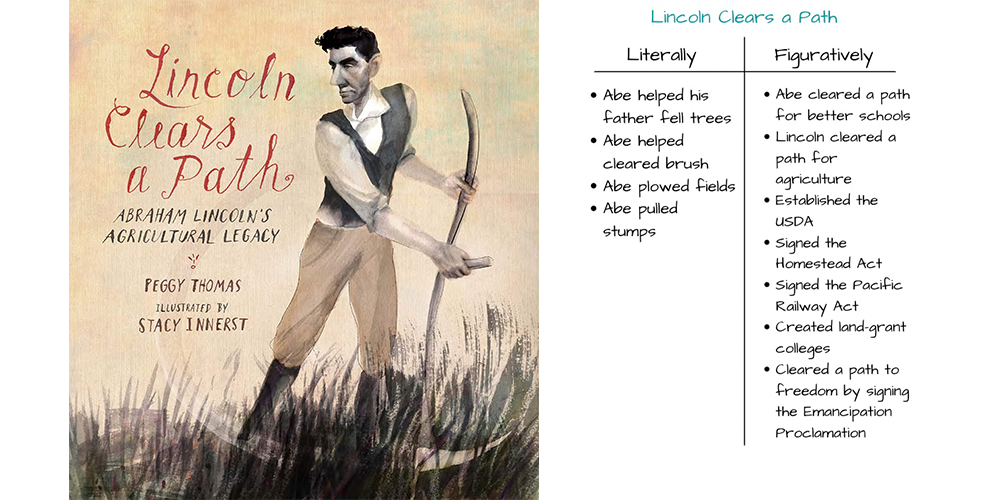Agricultural Literacy Curriculum Matrix
Lesson Plan
Abraham Lincoln Clears a Path: His Agricultural Legacy
Grade Level
Purpose
Students diagram the life of President Abraham Lincoln, including his childhood, presidency, and role during the Civil War, and describe his agricultural legacy and impact on agriculture today. Grades 3-5
Estimated Time
Materials Needed
Engage:
Activity 1: Lincoln Clears a Path
- Lincoln Clears a Path by Peggy Thomas
Activity 2: A Path for Lincoln
- Hexagon Tiles (individually cut out, 1 per student)
- Colored pencils
Vocabulary
United States Department of Agriculture (USDA): a federal agency responsible for developing and executing federal laws related to farming, forestry, and food
westward expansion: the 19th-century movement of settlers into the American West
Did You Know?
- During the Civil War, Lincoln asked farmers to cultivate all the land they had in order to feed and supply the Union Army.1
- Every month during the Civil War, farmers provided 48,750 bushels of beans and 8.5 million pounds of potatoes to feed 600,000 military men.1
- Abraham Lincoln established the United States Department of Agriculture (USDA) during the Civil War.1
- The USDA was established to support farmers who supported the military men during the Civil War. The USDA tested farm equipment and found the best seeds.1
Background Agricultural Connections
Abraham Lincoln is well known for his presidency during the Civil War, which included his fight for freedom, the passing of the Emancipation Proclamation, and his Gettysburg Address. What some might not realize, however, is his agricultural legacy.
Shortly after being elected the 16th president of the United States, the Civil War began. Abraham Lincoln quickly realized that those fighting for the Union army needed food and clothing, so Lincoln asked farmers to cultivate all of their land in order to support the military men. Because many of the men volunteered to fight in the army, wives, mothers, and sisters often times took over the farms. In 1862, there were 600,000 military men to feed and clothe. Each month during the Civil War, farmers provided 48,750 bushels of beans, 8.5 million pounds of potatoes, 24.3 million pounds of fresh beef, and over 130,000 barrels of flour.1 Lincoln recognized the hard work of the farmers feeding the army and decided the farmers needed additional support. Lincoln believed agriculture at the time was "the largest interest in the nation," and should have a proper department.1 On May 15, 1862, Abraham Lincoln established the United States Department of Agriculture (USDA). The USDA was created to support the farmers who were supporting the army. Support was offered to the farmers through the USDA by testing farm equipment and finding the best seeds for planting and harvesting. Today, the USDA continues to support farmers and ranchers while also promoting trade, protecting natural resources, and ensuring food safety.
In 1862, Abraham Lincoln continued his agricultural legacy by signing various acts that would impact the United States—and agriculture—for many generations. Within just a few short months, Abraham Lincoln signed the Homestead Act, the Pacific Railway Act, and the Morrill Act.
The Homestead Act (May 20, 1862)
Anyone over the age of 17, and who did not fight against the Union, was eligible to apply to receive 160 acres of public land. If granted the acreage, settlers were required to live on the land for five years and make improvements to the land, such as building a house and planting crops. By 1934, the government processed more than 1.6 million applications.1 Although this act was critical for westward expansion, it disrupted Native American nations who lived on the land given to homesteaders.
The Pacific Railway Act (July 1, 1862)
Abraham Lincoln signed the Pacific Railway Act in order to fund railway construction. The Union Pacifc Railroad Company started their railway in Missouri and worked west, while the Central Pacific Railroad Company started their railway in San Francisco and headed east. The two companies connected their railroad lines in Promontory, Utah, on May 10, 1869. This new railroad line, that spanned from the Missouri River to the Pacific Ocean, allowed citizens to travel the plains in eight days and offered farmers faster transportation for products.
The Morrill Act (July 2, 1862)
A representative from Vermont, by the name of Justin Morrill, proposed that the federal government grant each state 30,000 acres to establish at least one land-grant college. Land grant-universities were designed to teach agriculture, engineering, and mechanical arts. Some states already had public universities, so in response to this act, they created new agricultural colleges rather than adding to existing universities.3 In 1890, Justin Morrill proposed a second land-grant act that ensured African Americans equal access to colleges in southern states.1
During his presidency, Abraham Lincoln accelerated agricultural research, production, and education. The USDA was able to quickly spread information to farmers about new equipment and technologies, homesteading increased the number of farms throughout the west, railways provided quick transportation of livestock and crops across states, and land-grant universities furthered agricultural education and research.
Engage
- Project slide 1 from the Who am I? PowerPoint Slides.
- Explain to the students that you will read various clues as the blue squares disappear on the photo.
- Read a clue every 2-3 slides.
- Allow the students to make guesses between each clue. Write the students' guesses on the board.
- Continue reading clues as squares disappear.
- Once students have figured out that the clues are referring to Abraham Lincoln, ask if they know any other facts about Lincoln.
- Explain to the students that they are going to learn more about the 16th president, including his childhood, presidency, role during the Civil War, and influence on agriculture.

Explore and Explain
Activity 1: Lincoln Clears a Path
- Explain to the students that Abraham Lincoln often used the phrase, "clearing a path" in his writing. Ask the students, "What does it mean to clear a path?" (Someone can literally clear a path by removing trees, bushes, or stumps. Someone can figuratively clear a path by making changes that positively affect others, creating new laws, or leading the way to a new way of life.)
- Ask the students to create a T-chart on a piece of paper and title it, "Lincoln Clears a Path."
- Instruct the students to label one side of the chart "Literally" and the other side "Figuratively." Explain the difference between literal and figurative phrases.
- Literal phrases mean exactly what they say.
- Figurative phrases use similes, metaphors, hyperbole, and personification to describe something often through comparison with something different.
- As you read Lincoln Clears a Path by Peggy Thomas, ask the students to write down each time Lincoln "clears a path" in the correct column of the T-chart.

Activity 2: A Path for Lincoln
- Pass out a Hexagon Tile to each student. Explain that each tile represents an important part of Lincoln's life, the Civil War, or agriculture.
- Instruct the students to illustrate their tile according to the caption.
- When each student has finished their illustration, ask students to hang each of their tiles on the wall, connected to each other creating a "path." Allow the students to decide how to connect each of the hexagon tiles for the path. There is no one correct way to connect all the tiles. Allow the students to create their path as a class.
Activity 3: Lincoln's Agricultural Legacy
- Use the information from Lincoln Clears a Path by Peggy Thomas and the hexagon path from Activity 2 to lead a classroom discussion about Lincoln's impact on the United States and agriculture. Consider asking the following questions:
- What parts of Lincoln's childhood and young adult life prepared him to become President of the United States?
- What role did agriculture play during the Civil War?
- Is agriculture still important today? Why?
- How did Lincoln impact agriculture today?
- What is the purpose of the USDA today?
- What are land-grant universities?
- Does our state have a land-grant university? What is it called?
- How did the Pacific Railway Act benefit farmers and citizens?
- How did the Homestead Act benefit farmers, citizens, and immigrants?
- Reinforce the idea that Lincoln made changes in the 1800s that still impact us today.
- Ask students to consider how they are personally impacted by any of the acts that Lincoln signed in 1862. (Students might know someone who attended a land grant university; the USDA regulates programs like the school lunch program and MyPlate; students might have had ancestors who homesteaded in the western United States; etc.)
Evaluate
After conducting these activities, review and summarize the following key concepts:
- Agriculture was critical during the Civil War. Under the direction of Lincoln, many farmers provided food and clothing to the Union army.
- Abraham Lincoln improved and accelerated agricultural production, research, and education in the United States.
- The establishment of the USDA and the acts signed by Lincoln in 1862 still impact us today.
Sources
- Lincoln Clears a Path by Peggy Thomas
- https://www.history.com/topics/us-presidents/abraham-lincoln
- https://www.nap.edu/read/4980/chapter/2
Recommended Companion Resources
Author
Organization
| We welcome your feedback! If you have a question about this lesson or would like to report a broken link, please send us an email at [email protected]. If you have used this lesson and are willing to share your experience, we will provide you with a coupon code for 10% off your next purchase at AgClassroomStore. |
